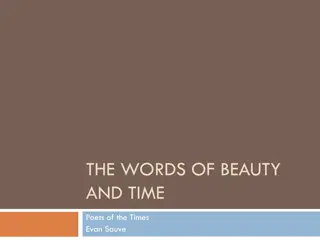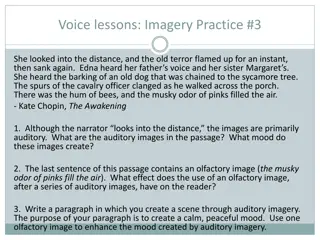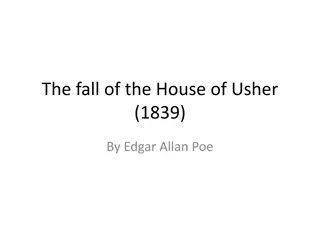Analysis and Symbolism in the Poem "The Raven" by Edgar Allan Poe
"The Raven" by Edgar Allan Poe is a narrative poem exploring themes of grief and psychological terror. The poem follows a distraught lover who is haunted by a talking raven that repeatedly utters the word "Nevermore," driving the protagonist into madness. Through the use of folklore, mythological, and classical references, Poe creates a dark and atmospheric work that remains a classic in literature.
Download Presentation

Please find below an Image/Link to download the presentation.
The content on the website is provided AS IS for your information and personal use only. It may not be sold, licensed, or shared on other websites without obtaining consent from the author. Download presentation by click this link. If you encounter any issues during the download, it is possible that the publisher has removed the file from their server.
E N D
Presentation Transcript
ANALYSIS AND SYMBOLISM IN THE POEM THE RAVEN A.J. SALEEMA KATHOON ASSISTANT PROFESSOR OF ENGLISH HAJEE KARUTHA ROWTHER HOWDIA COLLEGE,UTHAMAPALAYAM.
ABOUT THE POEM : "The Raven" is a narrative poem byAmerican writer Edgar Allan Poe. First published in January 1845, the poem is often noted for its musicality, stylized language, and supernatural atmosphere. It tells of a talking raven's mysterious visit to a distraught lover, tracing the man's slow descent into madness. The lover, often identified as a student,[1][2]is lamenting the loss of his love, Lenore. Sitting on a bust of Pallas, the raven seems to further distress the protagonist with its constant repetition of the word "Nevermore".
CONTINUES.... The poem makes use of folk, mythological, religious, and classical references. "The Raven" was first attributed to Poe in print in the New York Evening Mirror on January 29, 1845. Its publication made Poe popular in his lifetime, although it did not bring him much financial success. The poem was soon reprinted, parodied, and illustrated. Critical opinion is divided as to the poem's literary status, but it nevertheless remains one of the most famous poems ever written.[4]
THEMES : THE ISOLATING POWER OF GRIEF : The poem explores how grief can overcome a person s ability to live in the present and engage with society. Over the course of the poem, the speaker s inability to forget his lost love Lenore drives him to despair and madness. At the beginning, the speaker describes himself as weak and weary, suggesting that his attempts to distract himself from Lenore s memory by reading have only exhausted him. Although he is initially amused by the raven, the raven s word nevermore soon reminds the speaker of how he won t ever see Lenore again.
CONTINUES ... The power of this revelation moves him so deeply that he believes the air has grown denser, making it more difficult to breathe and emphasizing that Lenore s presence in his memory completely changes his perception of reality. Though the speaker tries to convince himself that he should forget his grief, the raven s refrain takes him back to the reality of his loss, again taking him out of the present moment. When he tells the raven to leave his loneliness unbroken, he s emphasizing that his grief has caused him to shut himself off from the world, but, paradoxically, he s not truly alone because the memory of Lenore keeps him company.
PSYCHOLOGICAL TERROR : Despite the poem s eerie atmosphere, everything that happens could actually have a rational explanation. The speaker begins the poem in an unsettled state, trying to distract himself from his grief, and the quaint and curious volume he reads could certainly put him in a dark and suggestible state of mind that the dreary December night only enhances. Ravens can imitate human speech, and a raven could theoretically make a noise similar to the word nevermore. However, the events of the poem are undeniably ghostly, and the bird s refrain perfectly suiting the speaker s mental state seems too coincidental, hinting at the presence of something supernatural.
CONTINUES... This ambiguity demonstrates both the mind s capacity to terrorize itself and the fact that psychological hauntings can disturb and destroy as much as physical danger. Whether we believe the bird can only repeat one word or whether it delivers a prophecy of doom, hearing nevermore a word that emphasizes the eternal nature of the speaker s grief and loss is what ultimately leaves the speaker mentally wrecked.
HOPELESSNESS : This ambiguity demonstrates both the mind s capacity to terrorize itself and the fact that psychological hauntings can disturb and destroy as much as physical danger. Whether we believe the bird can only repeat one word or whether it delivers a prophecy of doom, hearing nevermore a word that emphasizes the eternal nature of the speaker s grief and loss is what ultimately leaves the speaker mentally wrecked.
CONTINUES ... Again, the word nevermore dashes this hope as earlier in the poem, the speaker s own attempt to distract himself from grief by reading also failed. Finally, the speaker asks the raven about seeing Lenore in Heaven, which the raven again rejects. The bird s refrain, nevermore, is an inarguable absolute, meaning that nothing can change about the speaker s situation.
CONTINUES ... Because the speaker only asks the raven questions about Lenore after he establishes that the bird will always say nevermore, his pleas for mercy act as a self-fulfilling prophecy of despair. While we have ample textual evidence that the speaker will not see Lenore again and probably will not forget her, we cannot know whether or not the speaker will see Lenore in the afterlife, which suggests that he uses the raven s single word to reflect his own emotional state. He has placed himself in a position where he will only receive an answer that dooms him to endless sorrow, emphasizing that he has created his own hopelessness.
SYMBOLS IN THE POEM : There are primarily eight symbols in The Raven : the raven, lenore, night s plutonian shore, nepenthe, midnight, December, the bust of Pallas, and the speaker s chamber. All of these symbols work together to form a portrait of the speaker s grief.
LENORE: The narrator gives no description of Lenore. We do not know what she looks like or what exactly the relationship between Lenore and the narrator is. All we know is that the narrator really misses her. The lack of details regarding Lenore makes her a likely symbol. She may represent idealized love, beauty, truth, or hope in a better world. She is rare and radiant we are told several times, an angelic description, perhaps symbolic of heaven. Lenore may symbolize truth: the narrator cannot help but think of her, and her ubiquitous, yet elusive, nature haunts the narrative.
THE RAVEN : The most obvious symbol is contained in the poem s title. The raven enters the room imperiously and holds dominion over the narrator. The bird s darkness symbolizes death; hence, death becomes a constant reminder, an imperious intruder. If taken in a broader context, the poem may be about the inability of man to escape his ultimate fate, a reoccurring theme in Poe s short works.
NIGHTS PLUTONIAN SHORE : The phrase Night s Plutonian Shore incorporates all the negative aspects associated with death. Pluto is the Roman god of the underworld; hence, his shore would be the underworld. Combined with night, a common symbol for death and nothingness, and shore, representative of the vast ocean and all its mysterious inhabitants, Plutonian takes on an enhanced meaning.
NEPENTHE : Nepenthe:The narrator desperately searches for something that will remove his pain and suffering. This is symbolized by Nepenthe, an ancient drug used to help one relieve sorrows.
MIDNIGHT : Midnight:Traditionally referred to as the witching hour and the darkest part of night midnight is more than a number on the clock. It is no accident that Poe chooses this as the time for the bird s arrival.
THE BUST OF PALLAS : Pallas Athena was the Greek goddess of wisdom. It is upon this wisdom that the raven settles, adding credence, at least according to the narrator, to its utterances. The bust of Pallas and the raven s subsequent perch on it may be ironic, for it is the narrator that gives the bird such wisdom. A casual observer would assume the bird sits there because it seems like a logical resting place.
CONTINUOUS... . If you re ever in Europe, note how the pigeons perch themselves on statues in the centerof town. Only a moron would assume a bird takes on the character of a statue on which he perches. I don t think, for example, that a bird resting on Napoleon s shoulder suddenly becomes a ruthless general.
DECEMBER : December: Nothing lives in the winter. December is in the winter. December symbolizes death. I























